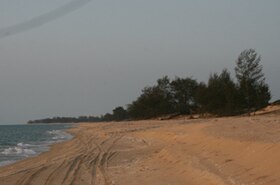Map all coordinates using OpenStreetMap
Download coordinates as:
| Pennefather | |
|---|---|
 Near Pennefather River mouth, in southwest Cape York Peninsula Near Pennefather River mouth, in southwest Cape York Peninsula | |
 | |
| Etymology | In honour of Charles de Fonblanque Pennefather |
| Location | |
| Country | Australia |
| State | Queensland |
| Region | Far North Queensland |
| Physical characteristics | |
| Source | |
| • location | Mapoon |
| • coordinates | 12°19′53″S 141°52′22″E / 12.33147°S 141.87289°E / -12.33147; 141.87289 (Pennefather River (source)) |
| • elevation | 20 m (66 ft) |
| Source confluence | Fish Creek and a series of unnamed waterways |
| • location | Port Musgrave Aggregation wetlands |
| • coordinates | 12°15′17″S 141°48′19″E / 12.25472°S 141.80528°E / -12.25472; 141.80528 (Confluence with Fish Creek) |
| • elevation | 1 m (3 ft 3 in) |
| Mouth | Gulf of Carpentaria |
| • location | south of Mapoon |
| • coordinates | 12°13′44″S 141°43′14″E / 12.22889°S 141.72056°E / -12.22889; 141.72056 (Pennefather River (mouth)) |
| • elevation | 0 m (0 ft) |
| Length | 11 km (6.8 mi) |
| Basin size | 3,009 km (1,162 sq mi) |
The Pennefather River is a river located on the western Cape York Peninsula in Far North Queensland, Australia.
Location and features
Formed by the confluence of a series of waterways including the Fish Creek in the Port Musgrave Aggregation estuarine wetlands, the Pennefather River flows due west, joined by the Turtle Creek from the north and Dingo Creek from the south, before emptying into the Gulf of Carpentaria south of Mapoon. The river descends 1 metre (3 ft 3 in) over its 11-kilometre (6.8 mi) course. At its widest point, the river is approximately 2 kilometres (1.2 mi) wide. The river has a catchment area of 3,009 square kilometres (1,162 sq mi), of which 349 square kilometres (135 sq mi) comprises wetlands.
Etymology and history
Yupanguthi (Yuputhimri, Jupangati, Yupangathi, Nggerikudi, Yupungati, Jupangati) is an Australian Aboriginal language spoken on Yupanguthi country. The Yupanguthi language region includes the landscape within the local government boundaries of the landscape within the local government boundaries of the Shire of Cook.
The river mouth was a site of the first recorded landfall in Australia by a Dutch explorer, by Willem Janszoon in 1606. Janszoon named it R. met het Bosch ("River with the Forest").
In 1802 the British explorer Matthew Flinders mistook the river for the Coen River, which had been named by Dutch explorer Jan Carstensz in 1623 (now the Archer River), so that the Bosch / Pennefather River was named Coen River on maps in the 19th century. In 1880, Captain Charles Edward de Fonblanque Pennefather established that there were now two Coen Rivers, and in 1894 Queensland authorities named the river after him, although the British Admiralty Chart for the Gulf of Carpentaria kept the name Coen River until 1967.
See also
References
- ^ "Pennefather River (entry 47589)". Queensland Place Names. Queensland Government. Retrieved 30 November 2015.
- ^ "Map of Pennefather River, QLD". Bonzle Digital Atlas of Australia. Retrieved 30 November 2015.
- "Wetland mapping — Pennefather River". WetlandInfo. Department of Environment and Heritage Protection, Queensland Government. 2015. Retrieved 1 December 2015.
-
 This Misplaced Pages article incorporates CC BY 4.0 licensed text from: "Yupanguthi". Queensland’s Aboriginal and Torres Strait Islander Languages map. State Library of Queensland. Retrieved 28 January 2020.
This Misplaced Pages article incorporates CC BY 4.0 licensed text from: "Yupanguthi". Queensland’s Aboriginal and Torres Strait Islander Languages map. State Library of Queensland. Retrieved 28 January 2020.
- Mutch, T. D. (1942). The First Discovery of Australia. Sydney: Project Gutenberg of Australia. p. 31. Retrieved 30 September 2012.
- Tent, Jan. "Geographic and Linguistic Reflections on Moent and Dubbelde Ree: Two of Australia's First Recorded Placenames" (PDF). Geographical Research. 44 (4): 372–385. Archived from the original (PDF) on 26 February 2015. Retrieved 10 November 2014.
- The name Coen River eventually was only retained by a southern tributary of the original Coen River.
- "Pennefather River". Project Gutenberg of Australia.
External links
- Heeres, J. E. (1894). "The Part Borne by the Dutch in the Discovery of Australia".
- "Newsletter of the Australian National Placenames Survey" (PDF). Placenames Australia. September 2005. Archived from the original (PDF) on 21 March 2006.
| Rivers of Queensland | |||||||||||||||
|---|---|---|---|---|---|---|---|---|---|---|---|---|---|---|---|
| |||||||||||||||
| |||||||||||||||
| |||||||||||||||
| |||||||||||||||
| |||||||||||||||